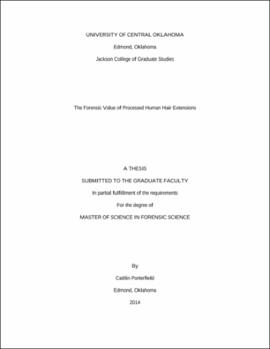| dc.contributor.advisor | Adams, Dwight | |
| dc.contributor.author | Porterfield, Caitlin | |
| dc.date.accessioned | 2020-07-10T20:14:32Z | |
| dc.date.available | 2020-07-10T20:14:32Z | |
| dc.date.issued | 2014 | |
| dc.identifier.other | (AlmaMMSId)9982433675102196 | |
| dc.identifier.uri | https://hdl.handle.net/11244/325202 | |
| dc.description.abstract | The human hair extension industry has grown immensely with revenues exceeding nine billion dollars each year. Statistics indicate that over sixty percent of women have at some point invested in hair extensions and that they are even becoming popular with men. In spite of the expansion of the extension consumer market, human hair extensions have never been evaluated for their evidentiary value in a forensic case. A human hair extension collected from a crime scene would be evaluated as a shed human telogen hair and analyze during microscopic techniques and mitochondrial DNA (mtDNA). Sequencing of mtDNA from the extension would place the hair donor, not the suspect, at the scene. Although it is not likely that the mtDNA sequence would be matched to the donor's maternal lineage, the evidence would be misleading. Hair extensions collected from a crime scene would misdirect an investigation and result in a misuse of time and resources. The ability to identify a human hair as an extension would be invaluable during an investigation and might exclude the hair as probative evidence. The human hair extension industry has grown immensely with revenues exceeding nine billion dollars each year. Statistics indicate that over sixty percent of women have at some point invested in hair extensions and that they are even becoming popular with men. In spite of the expansion of the extension consumer market, human hair extensions have never been evaluated for their evidentiary value in a forensic case. A human hair extension collected from a crime scene would be evaluated as a shed human telogen hair and analyze during microscopic techniques and mitochondrial DNA (mtDNA). Sequencing of mtDNA from the extension would place the hair donor, not the suspect, at the scene. Although it is not likely that the mtDNA sequence would be matched to the donor's maternal lineage, the evidence would be misleading. Hair extensions collected from a crime scene would misdirect an investigation and result in a misuse of time and resources. The ability to identify a human hair as an extension would be invaluable during an investigation and might exclude the hair as probative evidence. mtDNA extracted from the hair extensions was sequenced and compared to the revised Cambridge sequence (rCRS) to identify single nucleotide polymorphisms (SNPs). SNPs were used to assign haplotypes and distinguish regional affiliations associated with the extensions in an attempt to establish the ethnicity of the hair donor's maternal lineage. Haplotype assignments for the hair extensions were based on HV2 genetic polymorphisms and represented multiple geographic regions and a large portion of the population. HV2 sequences were not restrictive enough to determine regional affiliations for particular extension brands or processed human hair extensions as a whole. More definitive haplotype assignments would be possible with HV1 SNP discrimination. Also, sequence variation between hair extensions of the same brand indicated that the hair within a single package of extensions was from multiple donors. This has significant implications in forensic analysis. | |
| dc.rights | All rights reserved by the author, who has granted UCO Chambers Library the non-exclusive right to share this material in its online repositories. Contact UCO Chambers Library's Digital Initiatives Working Group at diwg@uco.edu for the permission policy on the use, reproduction or distribution of this material. | |
| dc.subject.lcsh | Forensic genetics | |
| dc.subject.lcsh | Hair extensions | |
| dc.title | The forensic value of processed human hair extensions. | |
| dc.type | Academic theses | |
| dc.contributor.committeeMember | Cassidy, Brandt | |
| dc.contributor.committeeMember | Creecy, James | |
| dc.thesis.degree | M.S., Forensic Science | |
| dc.subject.keywords | Processed human hair extensions | |
| dc.subject.keywords | Mitochondrial DNA | |
| dc.subject.keywords | Haplotype | |
| dc.subject.keywords | Hair microscopy | |
| dc.identifier.oclc | (OCoLC)ocn939609505 | |
| uco.group | UCO - Graduate Works and Theses::UCO - Theses | |
| thesis.degree.grantor | Jackson College of Graduate Studies | |
